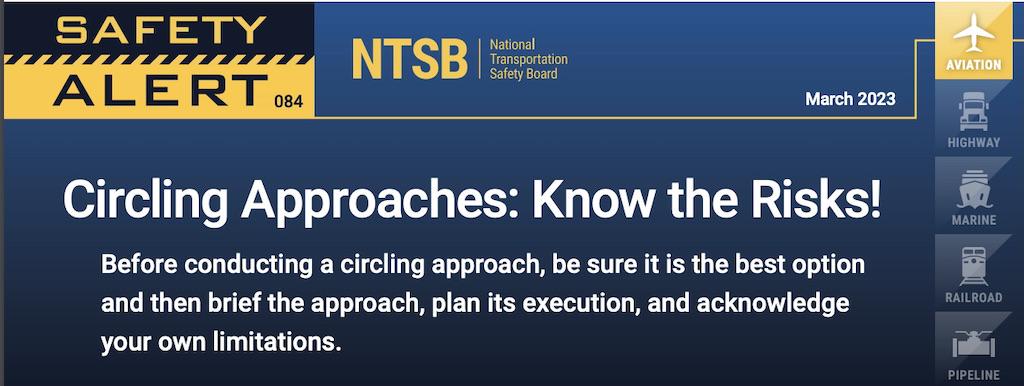Flying Circling Approaches In The Real World, Part 1

Earning an instrument and a type rating today still demands the applicant successfully fly a circling approach.
Despite the FAA’s recent Advisory Circular (AC) 120-123 calling for an increased focus on flight-path management, circling approaches have fallen into a Catch-22 status in which a pilot’s lack of proficiency seriously increases the risks when he or she is required to fly one of these approaches. With the proliferation of cockpit automation enabling RNAV GPS and RNP approaches around the world, however, circling approaches are nearing extinction, exacerbating the safety problem facing the industry when pilots choose to fly one.
The FAA’s Instrument Procedures Handbook (FAA-H-8083-16B) outlines the issue rather succinctly. “Circling approaches are one of the most challenging flight maneuvers conducted in the National Airspace System, especially for pilots of CAT C and CAT D turbine-powered, transport category airplanes. These maneuvers are conducted at low altitude, day and night, and often with precipitation present affecting visibility, depth perception and the ability to adequately assess the descent profile to the landing runway. Most often, circling approaches are conducted to runways without the benefit of electronic navigation aids to support the descent from the circling minimums decision altitude (CMDA) to the runway.”
Between 2008 and 2023, there were 10 accidents involving FAR Part 91 and Part 135 operators that occurred during a circling approach, according to a March 2023 NTSB safety alert (SA-084). Those accidents cost 17 lives. The SKYbrary electronic portal of safety information, says: “Studies have shown that runway aligned approaches (LNAV only) are some 25 times safer than circling approaches and that once some form of vertical guidance is added to these, the safety margin is increased again by some eight times.”
While the SKYbrary report is more than a decade old, it identified several circling approach accident risks that still exist for operators who fly them. Those threats include aircraft exceeding the obstacle clearance limits during the maneuver or a go-around and approaches that take the aircraft outside of its certified flight regime. All end the same way, with an aircraft experiencing controlled flight into terrain (CFIT).
Training vs. the Real World
Following discussions with several real-world business aviation pilots familiar with the inherent risks of circling to the landing runway, it’s clear there’s a significant difference between flying a circling approach in training and flying one in the real world. Again, because pilots seldom fly them, understanding the background upon which these circling approaches are based is critical.
The FAA published InFO 23001, “Use of Aircraft Approach Category During Instrument Approach Operations,” in January 2023 to spotlight one of the most important elements pilots must consider when a circling approach becomes a necessity: landing minimums. The agency reminded pilots that an aircraft’s certified approach category, and hence the landing minimums tied to that category, are completely independent of elements in the operating environment.
Consider a Hawker 800 that normally circles as a Category C aircraft. Despite the ceiling, the winds and its landing weight on any given day, that airplane will always remain as a Category C. Even if the pilot were able to fly the aircraft slowly enough to meet the speed restrictions of a Category B, approach minimums will never be less than those of the higher category.
If operational conditions such as gusty winds or icing exist, however, that Hawker 800 could be flown at a speed higher than the 120 kts. of Category C. This would demand the pilot fly the aircraft to the higher Category D landing minimums. The InFO also said: “Regardless of approach category when circling to land, the pilot must maneuver the aircraft within the circling approach protected area for that category to achieve the obstacle and terrain clearance provided by the procedure design criteria.” An advantage to pilots flying circling approaches today is that modern cockpit electronics allow them to draw circles outward from the runway threshold to aid them in staying within protected airspace.
Additional information contained in NTSB SA-084 reminds pilots that they “sometimes do not evaluate the risks of these approaches fully before accepting them, which can result in unstabilized approaches.”
When a pilot conducts a circling approach at a higher category speed limit, the FAA wants them to “consider several factors that can considerably alter the actual ground track flown, like bank angle. Using an excessively high bank angle when executing a circling approach can lead to an unstabilized approach and a possible loss of control.” Another factor is indicated airspeed. “Operating at a higher IAS demands pilots (positively) ensure they can still remain inside the circling approach’s protected airspace.”
The FAA also highlighted downwind turns because they affect the aircraft’s turn radius and hence the ability to remain within protected airspace. If an aircraft loses visual reference during the circling portion of a procedure, the pilot must follow the standard missed approach procedure. That means a turn toward the landing runway first in order to remain within the protected airspace.
The NTSB safety alert also reported faulty logic often pilots often used tied to circling approach accidents; the flight crew had many options available to them that would have increased the likelihood of executing a stabilized approach and a successful landing. For some reason, the pilots ignored these possibilities.
In Part 2 of this article, we’ll discuss the differences between PANS-OPS and TERPS approaches.




